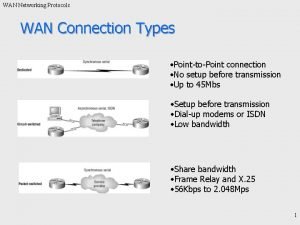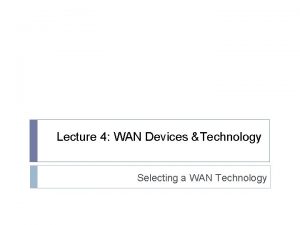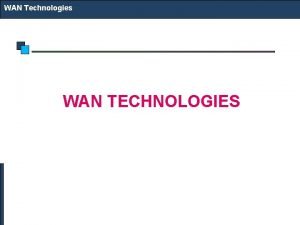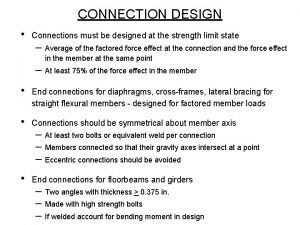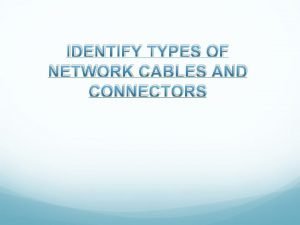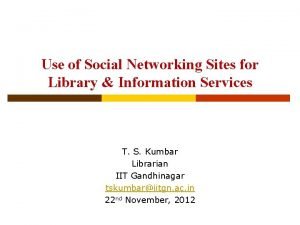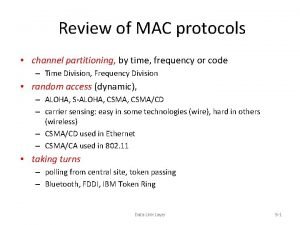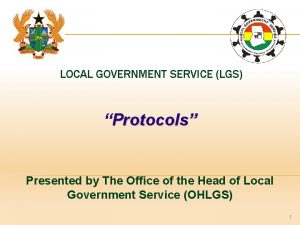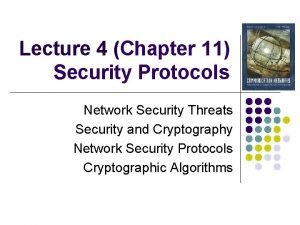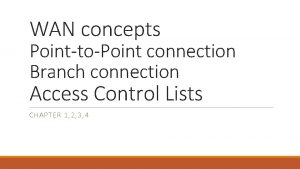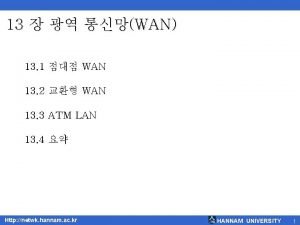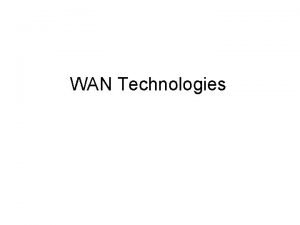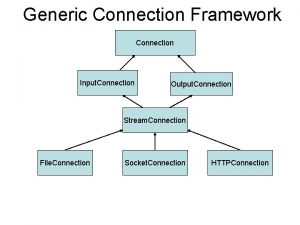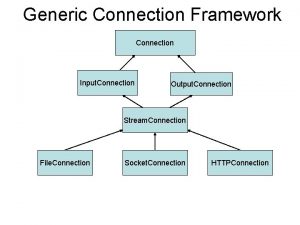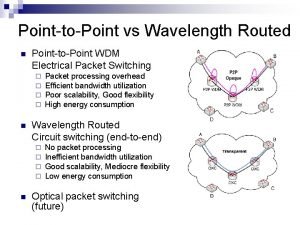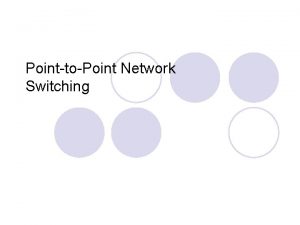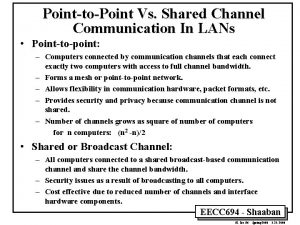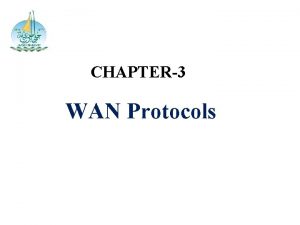WAN Networking Protocols WAN Connection Types PointtoPoint connection



















- Slides: 19

WAN Networking Protocols WAN Connection Types • Point-to-Point connection • No setup before transmission • Up to 45 Mbs • Setup before transmission • Dial-up modems or ISDN • Low bandwidth • Share bandwidth • Frame Relay and X. 25 • 56 Kbps to 2. 048 Mps 1

WAN Networking Protocols High-Level Data-Link Control Protocol • HDLC specifies an encapsulation method for data on synchronous serial data links using frame characters and checksums. • Default encapsulation used by CISCO. • Everyone has its own proprietary HDLC. • If your are connecting a CISCO router with another type router, you must specify an encapsulation type (protocol). 2

WAN Networking Protocols PPP • PPP is an Internet standard protocol to provide point-to-point, router-to-router, and host-tohost connections. • It supports network layer protocols – IP – Novell IPX – Apple Talk • It can be used over several different physical interfaces – Asynchronous serial – ISDN synchronous serial – High-speed Serial Interface 3

WAN Networking Protocols Establishing PPP Communication • Communication process is established in three steps: – Link Establishment – Authentication • Password Authentication (PAP) • Challenge Authentication Protocol (CHAP) – Network Layer Protocol negotiation 4

WAN Networking Protocols Link Establishment and LCP • Link Control Protocol (LCP) is responsible to configure and test the link. • LCP packets can contain many different pieces of information such as: – Authentication – Link Quality Monitoring and Magic Number – Compression 5

WAN Networking Protocols Configuring PPP on Cisco Routers 6

WAN Networking Protocols Frame Relay CSU/DSU (channel service unit/ digital service unit) • Frame Relay provides connection-oriented, Data Link layer communication via virtual circuits. • ANSI defines Frame Relay as a connection between the data terminal equipment (DTE) and the data communication equipment (DCE) over high speed digital medium. • CSU/DSU is located at customer location and used for encoding, filtering, and translating communication to and from the digital line. 7

WAN Networking Protocols Frame Relay • Supports many protocols, IP, Novell IPX, Decnet, Apple. Talk, . . • Efficient and fast (56 Kps to 44. 736 Mbps) since it does not perform error checking. • Uses both permanent virtual circuits (PVC) and switched virtual circuits (SPC). • Virtual circuits are maintained by a software and multiplexed on onto physical channels. 8

WAN Networking Protocols Data Link Connection Identifiers (DLCI) • Frame Relay virtual circuits are identified by DLCIs. • IP address need to be mapped DLCI 9

WAN Networking Protocols How Frame Relay works 10

WAN Networking Protocols Subinterfaces • You can have multiple virtual circuits on a single interface and treat each one as a separate interface. R(config)>interface s 0 R(config-if)>encapsulation frame-relay [ietf] R(config-if)>int s 0. 16 point-to-point (or multipoint) 11

WAN Networking Protocols Mapping Frame Relay Manual Mapping R(config)>interface s 0 R(config-if)>encapsulation frame-relay R(config-if)>int s 0. 16 multipoint R(config-subif)>no inverse-arp R(config-subif)>ip address 172. 16. 30. 1 255. 0 R(config-subif)>frame-relay map 172. 16. 30. 17 16 ietf broadcast R(config-subif)>frame-relay map 172. 16. 30. 18 17 broadcast R(config-subif)>frame-relay map 172. 16. 30. 19 18 Using Reverse-ARP R(config)>interface s 0. 16 R(config-subif)>encapsulation frame-relay ietf R(config-subif)>ip address 172. 16. 30. 1 255. 0 12

WAN Networking Protocols Integrated Services Digital Network (ISDN) • ISDN is a digital service designed to run over existing telephone networks. • ISDN supports both voice, video, and data • Call setup is faster than with a modem. • Data rates are faster than one modem connection. 13

WAN Networking Protocols ISDN Components 14

WAN Networking Protocols ISND Terminals • Terminal adapter: A converter device that allows non-ISDN devices to operate on an ISDN network. • Terminal Equipment 1 (TE 1): A device that supports ISDN standards. • Terminal Equipment 2 (TE 2): A non-ISDN device. • Network Termination 1 (NT 1): A device that is attached to ISND BRI lines to provide power. It also terminates the 2 -wire connection from CO and connects to the 4 -wire customer network. • Network Termination 2 (NT 2): A provider equipment. 15

WAN Networking Protocols Reference Points • U – The U-interface is the actual two-wire cable which connects the customer’s equipment to the telecommunications provider • R – The R-interface is the wire or circuit that connects TE 2 to the TA • S – The S-interface is a four-wire cable from TE 1 or TA to the NT 1 or NT 2 • T – The point between NT 1 and NT 2, which is also called the Tinterface • S/T 16

WAN Networking Protocols Connecting to the Provider 17

WAN Networking Protocols ISDN Switch Types • Interfaces – Basic Rate Interface (BRI) – Primary Rate (Interface) • Potential Switch Types To Be Obtained from ISDN Providers – basic-5 ess, basic-dms 100, basic-ni, . . • Service Profile Identifiers (SPIDs) – Reference number assigned to ISDN channels • Functions like a phone number – Frequently referred to as ISDN phone numbers – Most modern ISDN systems now have a feature called Auto. SPID 18

WAN Networking Protocols ISDN with CISCO Router 19
 Three dumb routers
Three dumb routers Type
Type Wan technologies overview
Wan technologies overview Ppp data link
Ppp data link Private wan infrastructure
Private wan infrastructure Wan technologies comparison
Wan technologies comparison Bolted connection
Bolted connection Shear plane in bolted connection
Shear plane in bolted connection Slip critical
Slip critical Text to text connections examples
Text to text connections examples Different types of network cables and connectors
Different types of network cables and connectors Types of social networking sites
Types of social networking sites Alarm types in networking
Alarm types in networking Elementary data link protocols
Elementary data link protocols Channel partitioning mac protocols
Channel partitioning mac protocols Proofs of work and bread pudding protocols
Proofs of work and bread pudding protocols Presentation layer
Presentation layer Network security protocols
Network security protocols Lgs protocols
Lgs protocols Network security protocols
Network security protocols

